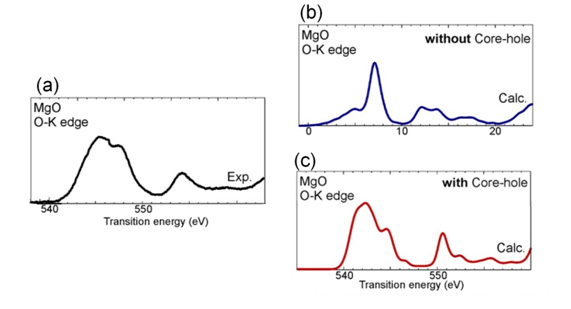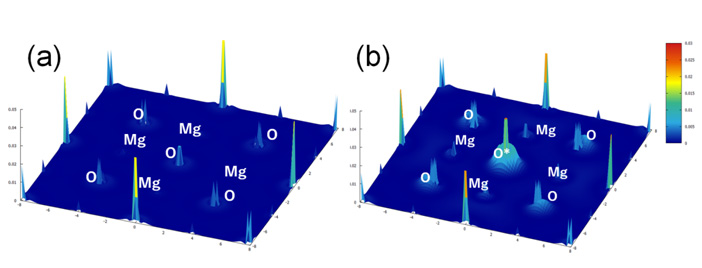core-hole interaction
core-hole interaction
Core-hole interaction means a Coulomb interaction between a hole created in an inner shell (a core-hole) and an excited electron, and the effect on the electronic structure caused by the core-hole. In the case of metals, the effect of the core-hole interaction is small because the free electrons screen the effect of the hole. However, in the case of oxides, the effect is large because oxides have no free electrons.
It has been known that conventional theoretical calculations cannot provide a good agreement with the experimental spectrum of an energy-loss near-edge structure (ELNES) in an EELS (electron energy-loss spectroscopy) spectrum obtained from an insulator (oxides, etc.). To solve this problem, the core-hole interaction has been introduced. When the ELNES spectra are calculated by taking account of the core-hole interaction, the experimental spectra are well reproduced.
The core-hole interaction causes the absorption edge of the EELS spectrum to shift to a lower energy side. The effect of the interaction is large when the energy difference between the excited electron and the hole is small.
Fig. 1(a) shows an experimental O-K ELNES spectrum of magnesium oxide (MgO). Fig. 2(b) shows a calculated spectrum of the same material without core-hole interaction. The two spectra do not show a good agreement in their shapes. Fig. 1(c) shows a calculated spectrum with core-hole interaction, where a core-hole is created in the inner shell (1s) of oxygen (O) and a strong Coulomb force between the hole and the excited electron is taken into account. For this spectral calculation, the core-hole interaction was taken into account, where a Coulomb force is strong against the excited electron. This spectrum is seen to show a much better agreement with the experimental spectrum. This enables us to understand the importance of the core-hole interaction for explaining the experimental ELNES spectra.
Fig. 2 compares the wave functions of the conduction electrons between the two cases (a) without a core-hole and (b) with the core-hole in the 1s orbital of the central oxygen atom (O*). It is seen that the intensity of the wave function near the central oxygen in (a) is higher than in (b). This is because Coulomb force received by the conduction electrons in the vicinity of the oxygen atom is stronger due to creation of the core-hole. Thus, the core-hole interaction is seen to affect the local spatial distribution of the wave function.
(By Professor Teruyasu Mizoguchi, The University of Tokyo)

Fig. 1 O-K ELNES spectra of MgO.
(a) Experimental ELNES spectrum.
(b) Calculated ELNES spectrum without the core-hole interaction.
(c) Calculated ELNES spectrum with the core-hole interaction.
The calculated ELNES spectrum which takes account of the core-hole interaction shows a much better agreement with the experimental spectrum.

Fig. 2
Squares of the wave functions of the conduction electrons of MgO (001) with and without the core hole.
(a) Square of the wave function without the core-hole interaction.
(b) Square of the wave function with the core-hole interaction.
The square of the wave function of the conduction electrons in (b) is seen to be larger near the central oxygen atom than that in (a).
Related Term(s)
Term(s) with "core-hole interaction" in the description
Are you a medical professional or personnel engaged in medical care?
No
Please be reminded that these pages are not intended to provide the general public with information about the products.




